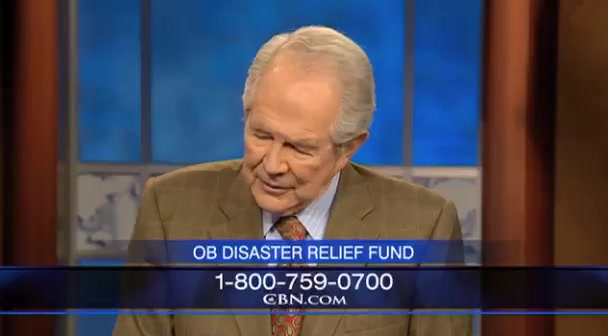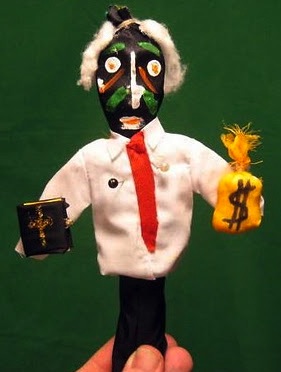Lazy Pat Robertson disease lives on
 Right up front, let me note that voodoo simply has to be one of the most confusing, complex and loaded subjects in the wide, wide, wide world of religion news. For starters, there is no such thing as a formalized, doctrinaire form of voodoo. There is no voodoo canon or hierarchy to which reporters can turn to settle issues of fact, history and interpretation. There is no orthodoxy in this syncretistic, melting pot faith. The voices inside voodoo are legion.
Right up front, let me note that voodoo simply has to be one of the most confusing, complex and loaded subjects in the wide, wide, wide world of religion news. For starters, there is no such thing as a formalized, doctrinaire form of voodoo. There is no voodoo canon or hierarchy to which reporters can turn to settle issues of fact, history and interpretation. There is no orthodoxy in this syncretistic, melting pot faith. The voices inside voodoo are legion.
At the same time, the faith's many critics rarely agree with one another. A traditional Catholic's criticisms of voodoo will be different than those made by a Pentecostal Christian and a Pentecostal Catholic's point of view may be different, on top of that. Oh, and there are strategic divisions inside those other camps on how to relate to the intense, foundational role that voodoo plays in a land such as Haiti.
So this brings us to a New York Times report on the renewed interest in voodoo in Haitian communities in New York City after last year's tragic earthquakes in Haiti.
Like I said, this is a complex subject and it appears that the Times tried really, really, hard to get half of this story right. Here is a crucial chunk of copy early on:
In New York, where there are roughly 300,000 people who were born in Haiti or are of Haitian descent -- the largest concentration in the United States -- richly painted basement voodoo temples are sprinkled around Harlem and in parts of Brooklyn and Queens. Mambos, or voodoo priestesses, say they can barely keep up with “demann,” or prayer requests; spiritual love recipes to lure recalcitrant lovers are the most popular. Voodoo prayer circles in which practitioners meet to commiserate have also proliferated, with a notable intensity in the months since the earthquake.
But the world of voodoo has fallen under an unwelcome spotlight in recent weeks as a result of two episodes in which the authorities say voodoo played a central role -- a fatal five-alarm fire in Brooklyn and the coming trial in Queens of a woman accused of severely burning her daughter.
The hot spotlight, we are told, is causing some voodoo believers to head underground, which can only make it harder for police and other civic authorities to understand this faith and, yes, to monitor those on its wild fringes.
When it comes to content, a key voice of authority in the Times story is Dowoti Desir, a Haitian-American expert who, readers are told, has a voodoo temple in her Harlem home:
Ms. Desir, a former professor in the Africana studies department at Brooklyn College, says voodoo has been vilified by Western culture going back to 1791, when a voodoo ceremony helped inspire slaves to rebel against their French colonial oppressors, sparking the Haitian Revolution.
Voodoo’s reputation inside and outside Haiti also suffered during the regime of François Duvalier, known as Papa Doc, who ruled Haiti from 1957 to 1971 and whose ruthless security force, the Tonton Macoutes, misused the religion as a means of repression. Mr. Duvalier even modeled himself after the Baron Samedi, the voodoo spirit of death, affecting a low nasal voice and wearing dark sunglasses to hide his eyes and instill fear and devotion.
After last year’s earthquake, some evangelical preachers, including Pat Robertson in the United States, said the catastrophe was related to Haiti’s “pact with the devil.”
 This passage raises all kinds of questions.
This passage raises all kinds of questions.
For example, what authorities are being quoted as saying that the faith advocated by the Tonton Macoutes represents a misuse of the religion "as a means of repression"? This implies that there is good voodoo and bad voodoo. What is the difference, in terms of rites and beliefs? By the way, who is the doctrinal authority that made this good-bad ruling? Is the Times quoting this voodoo scholar (one voice out of thousands on this topic) or did someone in the Times newsroom get to pass judgment on this?
Readers literally have no clue. This is bad.
Also, Pat Robertson -- last time I checked -- was a Pentecostal leader, not an evangelical, which is important distinction to make when one is dealing with Haiti and its growing Protestant churches.
Also, out of all of the critics of voodoo in the Christian world, how does Robertson rise, once again, to the top of the list? Why is an American from TV land the authority on this complex and emotional subject, as opposed to Haitian Pentecostals or Catholics who are actually involved in these debates in Haiti and in Haitian communities in North America?
Cynics will say that the answer is simply: Robertson is a straw man, beloved by lazy journalists.
This journalistic sin of commission and omission is important since this long story includes literally no other references to experts who are critical of voodoo and its role in Haitian culture. Click here for a sample of one such voice -- a calm and solid one -- speaking out on one of the hottest of hot topics, which is that voodoo event at the heart of Haitian history.
The story features plenty of voices on one side and -- oh joy -- Robertson on the other.
This is not a fair journalistic fight. Once again I have to ask: "Where are the Haitian voices on the other side of this issue? Where is the rest of this story?"
Photo: Yes, the second photo is of a Pat Robertson voodoo doll.